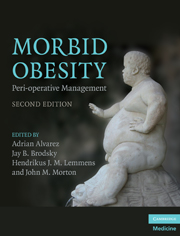
- Cited by 7
-
Cited byCrossref Citations
This Book has been cited by the following publications. This list is generated based on data provided by Crossref.
2011. Weighing in on Surgical Safety. AORN Journal, Vol. 93, Issue. 4, p. 518.
Torensma, Bart 2012. Meer gewicht vraagt om meer kennis!. Critical Care, Vol. 9, Issue. 5, p. 22.
Leykin, Yigal Miotto, Linda and Zannier, Gianfederico 2013. Controversies in the Anesthetic Management of the Obese Surgical Patient. p. 291.
Sheridan, Samantha 2015. A review of a self-diagnosed diabetic case study. Journal of Paramedic Practice, Vol. 7, Issue. 3, p. 132.
Soleimanpour, Hassan Safari, Saeid Sanaie, Sarvin Nazari, Mehdi and Alavian, Seyed Moayed 2017. Anesthetic Considerations in Patients Undergoing Bariatric Surgery: A Review Article. Anesthesiology and Pain Medicine, Vol. 7, Issue. 4,
John, Nimmy Martin, Daphne and Hoy, Leontia 2023. Anaesthetic nurse specialist role in perioperative anaesthetic management of patients who are morbidly obese. British Journal of Nursing, Vol. 32, Issue. 13, p. 644.
Torensma, Bart 2023. De anesthesiemedewerker. p. 285.
- Publisher:
- Cambridge University Press
- Online publication date:
- May 2010
- Print publication year:
- 2010
- Online ISBN:
- 9780511676307




